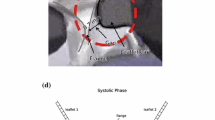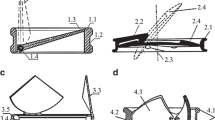Abstract
The aim of this study was to observe mechanical heart valve (MHV) cavitation pits resulting from in vivo testing of an electrohydraulic total artificial heart (EHTAH). During in vivo testing with three sets of valves (one set used in two animals), the slope of the driving pressure (left and right driving pressure) was used as a factor for investigating cavitation intensity, and the occurrence of cavitation was determined by the observation of cavitation pits on the explanted valve surfaces. Medtronic Hall valves were installed at the inlet and outlet positions of the two blood pumps. The EHTAH was tested using calves weighing 69–80 kg. The cavitation pits on the valve surface of the inlet valves of the left and right blood pumps were examined by scanning electron micrography. The driving pressure slope 5 ms before valve closure exceeded the cavitation threshold during in vitro testing. On both inlet valves, many large pits formed when the driving pressure slope was high and the pump operating time was long. When estimating cavitation intensity during in vivo testing, both a high driving pressure slope and a long operating time are important factors. The cavitation pits observed on the valve surfaces resulting from in vivo testing will eventually lead to leaflet fracture.
Similar content being viewed by others
References
Knapp RT, Daily JW, Hammitt FG. Cavitation. Iowa: Institute of Hydraulic Research, University of Iowa, 1979;218–223
Brennen CE. Cavitation and bubble dynamics. New York: Oxford University Press, 1995
Klepetko W, Moritz A, Mlczoch J, Schurawitzki H, Domanig E, Wolner E. Leaflet fracture in Edward-Duromedics bileaflet valves. J Thorac Cardiovasc Surg 1989;97:90–94
Kafesjian R, Howanec M, Ward GD, Diep L, Wagstaff LS, Rhee R. Cavitation damage of pyrolytic carbon in mechanical heart valves. J Heart Valve Dis 1994;3(Suppl. 1):S2–S7
Bottio T, Casarotto D, Thiene G, Caprili L, Angelini A, Gerosa G. Leaflet escape in a new bileaflet mechanical valve: TRI technologies. Circulation 2003;107:2303–2306
Zapanta CM, Stinebring DR, Sneckenberger DS, Deutsch S, Geselowitz DB, Tarbell JM, Snyder AJ, Rosenberg SG, Weiss WW, Pae WE, Pierce W. In vivo observation of cavitation on prosthetic heart valves. ASAIO J 1996;42:M550–M555
Graf T, Fischer H, Reul H, Rau G. Cavitation potential of mechanical heart valve prostheses. Int J Artif Organs 1991;14:169–174
Ryder JK, Cao H. Structural integrity assessment of heart valve prostheses: a damage tolerance analysis of the CarboMedics prosthetic heart valve. J Heart Valve Dis 1996;5(Suppl. 1):S86–S96
Akins CW. Review of the global experience with the Medtronic Hall valve. Eur J Cardiothorac Surg 1992;6(Suppl. 1):S68–S74
Butchart EG, Li HH, Payne N, Buchan K, Grunkemerier GL. Twenty years’ experience with the Medtronic Hall valve. J Thorac Cardiovasc Surg 2001;121:1090–1100
Nakata M, Masuzawa T, Tatsumi E, Taenaka Y, Nishimura T, Tsukiya T, Takano H, Tsuchimoto K, Ohba K. Characterization and optimization of the flow pattern inside a diaphragm blood pump based on flow visualization techniques. ASAIO J 1998;44:M714–M718
Lee HS, Taenaka Y, Kitamura S. Estimation of mechanical heart valve cavitation in an electro-hydraulic total artificial heart. Artif Organs 2006;30:16–23
Lee HS, Taenaka Y, Kitamura S. Mechanism for cavitation in the mechanical heart valve with an artificial heart: nuclei and viscosity dependence. Artif Organs 2005;29:41–46
Lee HS, Taenaka Y, Kitamura S. Cavitation phenomenon in monoleaflet mechanical heart valve with electrohydraulic total artificial heart. Int J Artif Organs 2004;27:779–786
Tatsumi E, Taenaka Y, Uesho K, Homma A, Nishinaka T, Kakuta Y, Tsukiya T, Takano H, Masuzawa T, Nakamura M, Koshiji K, Fukui Y, Tsukahara K, Tsuchimoto K, Wakui H. Current status of development and in vivo evaluation of the National Cardiovascular Center electrohydraulic total artificial heart system. J Artif Organs 2000;3:62–69
Lee HS, Yamamoto K, Kudo N, Shimooka T, Mitamura Y, Yuhta T. Examination of cavitation-induced surface erosion pitting of a mechanical heart valve using closing velocity. J Artif Organs 2002;5:193–199
Lukic B, Zapanta CM, Griffith KA, Weiss WJ. Effect of the diastolic and systolic duration on valve cavitation in a pediatric pulsatile ventricular assist device. ASAIO J 2005;51:546–550
Garrison LA, Lamson TC, Deutsch S, Geselowitz DB, Gaumond RP, Tarbell JM. An in-vitro investigation of prosthetic heart valve cavitation in blood. J Heart Valve Dis 1994;3(Suppl. 1):S8–S24
Author information
Authors and Affiliations
Corresponding author
Rights and permissions
About this article
Cite this article
Lee, H., Homma, A., Tatsumi, E. et al. Observation of cavitation pits on a mechanical heart valve surface in an artificial heart used in in vivo testing. J Artif Organs 12, 105–110 (2009). https://doi.org/10.1007/s10047-009-0458-3
Received:
Accepted:
Published:
Issue Date:
DOI: https://doi.org/10.1007/s10047-009-0458-3




